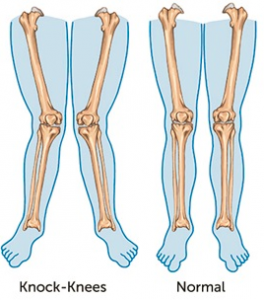Knock knees describes the position of the knees where they are turned inwards toward one another, meaning they ‘knock’ or brush against one another as you walk. It is medically known as genu valgum, and is common in children between the ages of 3 and 5. This knee position in young children can help maintain balance when developing their walking.
To learn more about kids’ foot problems,
click here.
What causes knock knees?
 Knock knees are usually a normal variation during the growth and development of the lower limbs. Where knock knees don’t develop until the age of 6 or persist after the age of 8, there may be an underlying condition such as rickets or osteomalacia. Contributing factors to the development of knock knees include:
Knock knees are usually a normal variation during the growth and development of the lower limbs. Where knock knees don’t develop until the age of 6 or persist after the age of 8, there may be an underlying condition such as rickets or osteomalacia. Contributing factors to the development of knock knees include:
- Obesity
- Loose ligaments in the knees that place excess pressure on the knee joints
- Infection or injury to the knee or shin bone (tibia)
- Conditions that affect bone development
- Calcium or Vitamin D deficiency
What are the symptoms?
The primary symptom of knock knees is knee misalignment where the knees bend inwards. When the knees are together, a significant gap between the ankles can be observed. One knee may turn inwards more than the other and pain isn’t typically experience during young childhood years. Where knock knees continue beyond the childhood years, symptoms may include:
- Knee pain
- Limping or altered walking patterns
- Stiffness in the knee joints
- Increased risk of developing knee arthritis
How is it treated?
The majority of knock knees in young children are reported to resolve by the age of 7 and aren’t usually of great concern. Where knock knees persist into adulthood, management needs to be aimed at the issues that this misalignment is creating as opposed to the knee position itself. In later years, it is also important to rule out the possibility of any underlying bone conditions. Your podiatrist will be able to create a tailored management plan based on the symptoms you’re experiencing and your history.
 Knock knees are usually a normal variation during the growth and development of the lower limbs. Where knock knees don’t develop until the age of 6 or persist after the age of 8, there may be an underlying condition such as rickets or osteomalacia. Contributing factors to the development of knock knees include:
Knock knees are usually a normal variation during the growth and development of the lower limbs. Where knock knees don’t develop until the age of 6 or persist after the age of 8, there may be an underlying condition such as rickets or osteomalacia. Contributing factors to the development of knock knees include:








